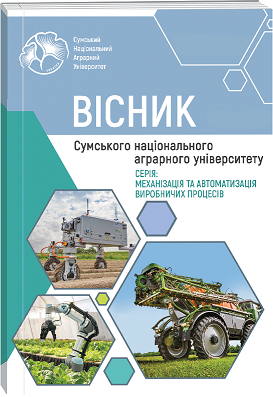CORN SEED PREPARATION BY ELECTROMAGNETIC RADIATION IN DIFFERENT MODES AS A WAY OF YIELD INCREASE
Abstract
The article analyzes the impact of electromagnetic radiation (EMR) in the red (660 nm), blue (460 nm) ranges, and combined exposure, during 10 and 30 minutes for each type of exposure. The most common agricultural crops – corn, were chosen for the experiments. Unirradiated seeds were used as a control. The energy of germination and laboratory germination and additionally the length of roots and seedlings were studied. The obtained results showed that the most significant effect on the energy of germination and laboratory germination had a variant of the combined action of both the red and blue ranges for 30 minutes. This mode of treatment in laboratory conditions that shows the possibilities of activating the biopotential of seeds. Thus, it is the activation of a group of different photoreceptors, both and phytochromes and cryptochromes, that is most effective. Treatment for 10 minutes had almost no effect with all wavelengths. This may be due to the fact that the effect of EMR has a prolonged effect and may be showed later. Germination energy and germination are studied at the initial (first week) stage of growth. In the comparison of different agricultural crops used in the experiment, the most noticeable effect was found in the case of corn. This can be explained, first of all, by the size of the seed, which is the largest in corn, and therefore has the largest surface area. In second place are wheat and rapeseed, for which the difference with the control. Secondly, the discovered fact can be explained by the features of biochemical processes, in particular their speed, which requires further study. Overall, the increase in laboratory similarity in seed germination energy, which is insignificant in laboratory conditions, but can have a significant effect in field research conditions, taking into account weather conditions and other growing factors. No pattern of changes in the indicators of the length of roots and sprouts was found in all variants of the experiment. This may indicate the insensitivity of this indicator to EMRV treatment.
References
2. Bezpal’ko, V., Stankevych, S., & Matsyura, A. (2021). Pre-sowing treatment of winter wheat and spring barley seeds with the extremely high frequencies electromagnetic field. Ukrainian Journal of Ecology, 11(1), 62–71. https://doi.org/10.15421/2021_9
3. Downs, R. J. and Thomas J. F. (1982). Phytochrome regulation of flowering in the long-day plant, Hyoscyamusniger. Plant Physiol. 70: 898–900.
4. Goins G. D., Yorio, N. C., Sanwo, M. M. and Brown, C. S. (1997). Photomorphogenesis, photosynthesis and seed yield of wheat plants grown under red light-emitting diodes (LEDs) with and without supplemental blue lighting. J Exp Bot. 48: 1407–1413.
5. Govindaraj, M., Masilamani, P., Albert, V. A., & Bhaskaran, M. (2017). Effect of physical seed treatment on yield and quality of crops: A review. Agricultural Reviews, OF. https://doi.org/10.18805/ag.v0iof.7304
6. Li, Q. H., & Yang, H. Q. (2007). Cryptochrome Signaling in Plants†. Photochemistry and Photobiology, 83(1), 94–101. https://doi.org/10.1562/2006-02-28-ir-826
7. Li, H., Tang, C., Xu Z., Liu, X. and Han, X. (2012). Effects of different light sources on the growth of non heading Chinese cabbage (Brassica campestris L.). J Agr Sci. 4: 262–273.
8. Lysyshenko, M., Pankova, O. (2016). Intensyfikatsiia biokhimichnykh protsesiv u nasinni silskohospodarskykh kultur. Inzheneriia Pryrodokorystuvannia, 44–47 (№ 2 (6)). [Method of intensification of seeds crops vital activity] https://repo.btu.kharkov.ua/handle/123456789/2975 (in Ukrainian).
9. Pankova O.V. Proteoliz riznykh sortiv yachmeniu v zalezhnosti vid obrobky nasinnia monokhromatychnym optychnym vyprominiuvanniam chervonoho diapazonu. (2010). Fotobiolohiia Ta Fotomedytsyna, 3–4, 66–69. [Proteolysis of different sorts of barley in dependence on treatment of seeds by monochromatic optical radiation of red range of spectrum] http://fnfjournal.univer.kharkov.ua/Ua/nomera/3_4_2010.pdf (in Ukrainian).
10. Pankova, O., Puzik, V., & Lysishenko, M. (2021). Vplyv elektromahnitnoho vyprominiuvannia na roslyny. TOV «Planeta-Print», Kharkiv, 159. [The influence of electromagnetic radiation on plants] https://repo.btu.kharkov.ua/bitstream/123456789/8096/3/Pankova_Effect_of_electromagnetic_radiation_monograph_2021.pdf (in Ukrainian).
11. Pons, T. L. (2000) Seed responses to light. In Fenner M (ed). Seeds: The Ecology of Regeneration in Plant Communities, 2nd ed. Wallingford, UK: CABI Publishing, 237–60.
12. Saebo, A., Krekling, T. and Appelgren, M. (1995). Light quality affects photosynthesis and leaf anatomy of brich plantlets in vitro. Plant Cell Tiss Org. 41:177–185.
13. Simpson, G. G. and Dean, C. (2002). Arabidopsis, the Rosetta stone of flowering time? Science. 296: 285–289.
14. Singh, D., Basu, C., Meinhardt-Wollweber, M. and Roth, B. (2015). LEDs for energy efficient greenhouse lighting. Renewable Sustainable Energy Rev. 49: 139–147.
15. Stutte, G. W., Edney, S. and Skerritt, T., (2009). Photoregulation of bioprotectant content of red leaf lettuce with lightemitting diodes. Hort Science. 44: 79–82.
16. Yanagi, T. and Okamoto. K. (1997). Utilization of super-bright light emitting diodes as an artificial light source for plant growth. Acta Hort. 418: 223–228.

 ISSN
ISSN  ISSN
ISSN 



